
|
Not yet observed on the earth in this return. But it was already visible in the SWAN images in mid March, and in the LASCO images in early April. It is brihtening very rapidly towards the perihelion passage on Apr. 4. It will appear in the morning sky at 8 mag in mid April in the Northern Hemisphere, or at 10 mag in late April in the Southern Hemisphere. Then the condition will get better rapidly. However, the comet will fade out rapidly. It will be fainter than 14 mag in mid May, too faint to see visually.
Date(TT) R.A. (2000) Decl. Delta r Elong. m1 Best Time(A, h)
Mar. 31 1 2.05 -4 16.3 1.138 0.239 10 5.0 19:20 ( 80, -8)
Apr. 7 1 1.60 15 46.0 0.943 0.166 9 2.4 19:11 ( 93,-23)
|
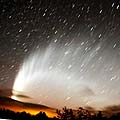
|
Excellent great comet, few times in a lifetime, for southern people. It reached to -5.5 mag on Jan. 14 and 15, brighter than Venus, and visible even in daytime. Then it appeared in the evening sky in the Southern Hemisphere and many people enjoyed a fantastic view of a beautiful great comet, a enormous curving tail with so many striae over 50 degrees. Now it is observable both in the evening and morning. It has already faded down to 8.3 mag (Mar. 31, Walter Ruben Robledo). In the Southern Hemisphere, It keeps observable almost all night until the comet has gone. It will never be observable again in the Northern Hemisphere. It passes near by the Small Magellanic Cloud in early April.
Date(TT) R.A. (2000) Decl. Delta r Elong. m1 Best Time(A, h)
Mar. 31 23 33.96 -70 23.2 1.825 1.839 74 7.8 4:47 (337, 31)
Apr. 7 23 54.33 -72 30.3 1.868 1.957 79 8.1 4:52 (339, 33)
|

|
It will reach to 6 mag at the perihelion passage in mid April. It brightened rapidly in the evening sky in March. But now it locates extremely low and hard to observe. It will be unobservable in mid April. After conjunction with the sun, it appears in the morning sky at 12 mag in June. But it locates only 20 degree high at most, and it will be fading rapidly. In the Southern Hemisphere, it appears in the morning sky at 8 mag in May, then it will be bright and observable for a while.
Date(TT) R.A. (2000) Decl. Delta r Elong. m1 Best Time(A, h)
Mar. 31 1 55.37 17 11.1 1.354 0.593 23 9.4 19:20 (105, -9)
Apr. 7 2 21.69 18 19.4 1.185 0.468 22 8.4 19:11 (107, -8)
|
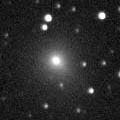
|
New bright comet discovered visually in the Southern Hemisphere. It seems to have been brightening gradually during last several months in the southern sky. It is moving northwards fast. It will become observable also in the Northern Hemisphere in the morning sky after early April. It will pass close to the earth and reach to 8 mag in April. Then it keeps observable until it fades out in the Northern Hemisphere. It will be visible visually until July.
Date(TT) R.A. (2000) Decl. Delta r Elong. m1 Best Time(A, h)
Mar. 31 20 20.91 -40 17.9 0.827 1.095 72 8.8 4:47 (293, 54)
Apr. 7 20 5.44 -31 38.5 0.676 1.107 80 8.4 4:52 (273, 62)
|
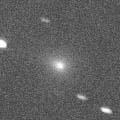
|
First return of a new bright periodic comet observed at 9 mag in 2001. It brightened rapidly also in this return. It was 16.1 mag on Jan. 11 (Filip Fratev), but it brightened up to 11.1 mag on Mar. 11 (Reinder J. Bouma). Unexpectedly, it became as bright as at the discovery, and visible visually. However, the condition of this apparition is bad. It keeps locating very low in the evening until early May. It has already turned to be fading.
Date(TT) R.A. (2000) Decl. Delta r Elong. m1 Best Time(A, h)
Mar. 31 3 0.61 10 28.2 1.687 1.064 36 12.5 19:20 (109, 8)
Apr. 7 3 32.66 11 40.7 1.724 1.114 37 13.0 19:11 (112, 10)
|

|
Bright as 13.8 mag visually (Mar. 17, Alan Hale). Approaching to the earth rapidly now, and it will reach to 13 mag in early April. It is observable in good condition. However, it will fade out rapidly after that, and it will be low in the evening sky soon. It will be unobservabel in late May.
Date(TT) R.A. (2000) Decl. Delta r Elong. m1 Best Time(A, h)
Mar. 31 12 47.99 -16 13.3 0.524 1.514 167 13.4 0:22 (180, 72)
Apr. 7 11 3.58 -3 45.6 0.506 1.463 150 13.2 21:54 (180, 58)
|

|
Now it is 12.6 mag (Mar. 9, Edwin van Dijk). It has been 12 mag for half a year since last June. But it will start fading after this. It will be too faint to see visually in April. However, the fading is slow. The comet will be fainter than 18 mag in 2008. In the Northern Hemisphere, it keeps observable until that time. In the Northern Hemisphere, it keeps observable all night for a while after this.
Date(TT) R.A. (2000) Decl. Delta r Elong. m1 Best Time(A, h)
Mar. 31 23 22.80 71 11.0 2.723 2.530 68 13.7 4:47 (203,-33)
Apr. 7 0 10.21 71 38.5 2.828 2.580 65 13.9 4:52 (202,-34)
|

|
In this season, it has been bright as 12-13 mag and visible visually since it appeared in the morning sky in early July. It is visible visually as 12.7 mag still now (Mar. 17, Carlos Labordena). It will be getting lower in the evening sky after this. It will be too low to see in April.
Date(TT) R.A. (2000) Decl. Delta r Elong. m1 Best Time(A, h)
Mar. 31 4 8.00 28 31.4 6.397 5.896 55 13.8 19:20 (132, 7)
Apr. 7 4 12.93 28 35.1 6.489 5.898 50 13.8 19:11 (130, 5)
|

|
Now it is 14.1 mag (Mar. 20, Luis Alberto Mansilla). It has been 13 mag for a long time since last autumn. However, it will be fading gradually after this. It is observable in good condition in the Southern Hemisphere, although it is already not observable in the Northern Hemisphere.
Date(TT) R.A. (2000) Decl. Delta r Elong. m1 Best Time(A, h)
Mar. 31 16 34.87 -72 40.3 1.985 2.406 102 14.4 4:04 ( 0, 52)
Apr. 7 16 38.86 -73 28.4 1.980 2.452 105 14.5 3:40 ( 0, 52)
|
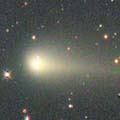
|
It reached up to 9.3 mag between October and November (Oct. 27, Juan Jose Gonzalez). It had been observable in excellent condition. But it is fading now. It has already faded down to 13.1 mag (Mar. 8, Reinder J. Bouma). However, it keeps observable after this until May when it fades down to 16 mag.
Date(TT) R.A. (2000) Decl. Delta r Elong. m1 Best Time(A, h)
Mar. 31 5 30.33 14 28.7 2.178 2.116 73 14.5 19:20 (139, 30)
Apr. 7 5 44.65 14 53.3 2.286 2.155 69 14.8 19:11 (139, 29)
|

|
It has been visible at 13.5 mag for a long time since 2005 autumn until 2006 spring. Now it is fainter than last year by 1 mag, however, it is still visible visually at 14.2 mag (Dec. 22, Seiichi Yoshida). It keeps observable in excellent condition until April.
Date(TT) R.A. (2000) Decl. Delta r Elong. m1 Best Time(A, h)
Mar. 31 12 56.70 24 9.8 4.931 5.828 151 14.6 0:26 (180, 31)
Apr. 7 12 53.38 24 4.7 4.969 5.851 149 14.6 23:51 (180, 31)
|

|
It reached up to 4 mag in 2006 autumn. But it had faded down to 10.5 mag on Jan. 11 (Carlos Labordena). Now it is not observable. It will appear in the morning sky again at 15-16 mag in May. Then it keeps observable until it becomes fainter than 18 mag in autumn.
Date(TT) R.A. (2000) Decl. Delta r Elong. m1 Best Time(A, h)
Mar. 31 22 41.44 -8 51.1 3.771 2.963 31 14.7 4:47 (272, 13)
Apr. 7 22 46.35 -9 8.7 3.785 3.048 37 14.9 4:52 (268, 19)
|
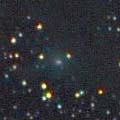
|
It became brighter than expected, and now it is visible visually at 14.2 mag (Mar. 14, Alan Hale). It keeps observable in the evening sky until May. It is not observable around the perihelion passage in July in conjunction with the sun. Then it moves to the southern sky, and it will be unobservable in the Northern Hemisphere.
Date(TT) R.A. (2000) Decl. Delta r Elong. m1 Best Time(A, h)
Mar. 31 4 23.86 41 29.3 2.560 2.289 63 15.1 19:20 (144, 0)
Apr. 7 4 40.36 40 33.5 2.577 2.238 59 15.1 19:11 (143, 0)
|

|
Now it is 15.2 mag (Feb. 24, Ken-ichi Kadota). Although it had been unobservable since last autumn, now it is appearing again in the morning sky. It will be observable at 14.5 mag from spring to summer both in 2007 and 2008. The condition is good, and it may be visible visually.
Date(TT) R.A. (2000) Decl. Delta r Elong. m1 Best Time(A, h)
Mar. 31 18 59.30 -11 15.3 5.978 5.975 85 15.2 4:47 (230, 57)
Apr. 7 18 57.35 -10 37.9 5.834 5.958 92 15.2 4:52 (216, 61)
|

|
Now it is 14.4 mag (Feb. 12, Juan Jose Gonzalez). Almost asteroidal. It did not brighten at all since early September. Although the slight cometary activity was detected in late July, it became completely stellar soon. Its tail became visible again in late October, however, it turned to be stellar again soon. Finally it has passed the perihelion, keeping almost asteroidal. It kept observable at 14 mag in good condition in the Northern Hemisphere for a long time. However, it will be fading after this. It will start getting lower in April, and will be too low in the evening sky at 17 mag in June.
Date(TT) R.A. (2000) Decl. Delta r Elong. m1 Best Time(A, h)
Mar. 31 6 37.60 19 43.7 1.413 1.717 89 15.3 19:20 (159, 33)
Apr. 7 6 54.81 17 29.0 1.535 1.780 86 15.5 19:11 (158, 35)
|
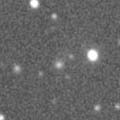
|
Now it brightened up to 16.0 mag (Feb. 21, Ken-ichi Kadota). It keeps 15.5-16 mag for one year and a half after this until 2008 summer. However, because the comet moves southwards, it is only observable until 2007 June in the Northern Hemisphere.
Date(TT) R.A. (2000) Decl. Delta r Elong. m1 Best Time(A, h)
Mar. 31 10 23.88 1 27.5 2.746 3.621 146 16.0 21:49 (180, 54)
Apr. 7 10 19.76 1 8.7 2.761 3.576 138 15.9 21:18 (180, 54)
|

|
It was observed at 19 mag in mid December. It brightened up to 18 mag on Feb. 15. It will reach to 17 mag in spring, and will be observable in good condition.
Date(TT) R.A. (2000) Decl. Delta r Elong. m1 Best Time(A, h)
Mar. 31 10 42.37 7 23.1 1.364 2.282 149 17.0 22:08 (180, 48)
Apr. 7 10 40.25 7 48.0 1.394 2.268 141 17.1 21:38 (180, 47)
|
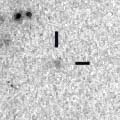
|
It was observed at 17.5 mag in 2006 spring. It will be observable at 17 mag in good condition in 2007 spring.
Date(TT) R.A. (2000) Decl. Delta r Elong. m1 Best Time(A, h)
Mar. 31 14 7.36 -12 57.4 3.799 4.727 155 17.1 1:37 (180, 68)
Apr. 7 14 4.27 -12 45.6 3.761 4.728 163 17.1 1:06 (180, 68)
|

|
Now it is 16.8 mag (Dec. 29, Katsumi Yoshimoto). It is outside of Jupiter's orbit. So it keeps 17 mag for a long time until 2007 summer. It keeps locating high and observable in good condition for a long time after this because it moves in the northern sky.
Date(TT) R.A. (2000) Decl. Delta r Elong. m1 Best Time(A, h)
Mar. 31 14 29.49 40 46.6 6.647 7.309 128 17.1 1:59 (180, 14)
Apr. 7 14 24.70 40 48.0 6.655 7.325 128 17.1 1:26 (180, 14)
|

|
It reached to 16 mag in early 2006. Now it is 17.3 mag (Dec. 2, Ken-ichi Kadota). It will be fading very slowly from 17 mag to 18 mag until 2007 summer. In the Northern Hemisphere, it keeps locating high.
Date(TT) R.A. (2000) Decl. Delta r Elong. m1 Best Time(A, h)
Mar. 31 14 10.80 34 26.1 5.126 5.882 135 17.4 1:40 (180, 21)
Apr. 7 14 6.97 34 27.8 5.147 5.910 136 17.4 1:09 (180, 21)
|

|
It has already faded down to 16.3 mag (Jan. 30, Ken-ichi Kadota). It keeps a good contition until spring, while the comet will be fading gradually.
Date(TT) R.A. (2000) Decl. Delta r Elong. m1 Best Time(A, h)
Mar. 31 9 4.93 25 57.5 4.317 4.905 120 17.5 20:31 (180, 29)
Apr. 7 9 4.16 25 38.7 4.476 4.969 114 17.6 20:03 (180, 29)
|

|
Very far new comet. It will be observable at 17.5-18 mag more than one year after this.
Date(TT) R.A. (2000) Decl. Delta r Elong. m1 Best Time(A, h)
Mar. 31 9 37.32 -4 0.7 8.060 8.799 135 17.5 21:03 (180, 59)
Apr. 7 9 36.80 -3 31.1 8.134 8.798 128 17.5 20:35 (180, 59)
|

|
It reached to 16.5 mag at best in December and January. But now it is already fading. It will be fainer than 18 mag in April.
Date(TT) R.A. (2000) Decl. Delta r Elong. m1 Best Time(A, h)
Mar. 31 6 49.82 26 14.2 2.128 2.372 91 17.9 19:20 (164, 27)
Apr. 7 6 59.68 25 49.8 2.219 2.382 86 18.0 19:11 (162, 27)
|

|
Peculiar asteroid moving along a cometary orbit. It will approach to Sun down to 0.6 A.U. in late April. Then it will pass very near by Earth in May. The condition to observe it is very bad. Nobody can observe it until late May in the Northern Hemisphere. In the Southern Hemisphere, it will be observable in the morning low sky from late April to mid May. It will be 18.5 mag at best if it keeps asteroidal. However, if it shows cometary activity, it may be observed at 12-14 mag in the Southern Hemisphere. Then it may be visible visually at 11 mag in the evening sky in late May also in the Northern Hemisphere.
Date(TT) R.A. (2000) Decl. Delta r Elong. m1 Best Time(A, h)
Mar. 31 0 41.04 -5 10.7 1.821 0.850 9 18.6 19:20 ( 75,-12)
Apr. 7 0 40.61 -6 28.0 1.684 0.754 14 18.5 4:52 (282, -6)
|

|
It had been lost since its discovery in 1986. But it was rediscovered on Jan. 9 at 16-17 mag. The condition is good in this return, and it was expected to reach to 14 mag from autumn to winter. But actually, it is fainter than originally expected, and it reached to 17 mag at best. Now it is 17.4 mag (Feb. 11, Mitsunori Tsumura). It will be fainter than 18 mag soon.
Date(TT) R.A. (2000) Decl. Delta r Elong. m1 Best Time(A, h)
Mar. 31 2 49.98 16 59.2 2.545 1.824 35 19.1 19:20 (112, 1)
Apr. 7 3 8.35 18 13.1 2.628 1.869 33 19.3 19:11 (113, 1)
|
|
![]()
 C/2006 P1 ( McNaught )
C/2006 P1 ( McNaught ) 2P/Encke
2P/Encke C/2007 E2 ( Lovejoy )
C/2007 E2 ( Lovejoy ) 185P/2007 A3 ( Petriew )
185P/2007 A3 ( Petriew ) C/2007 E1 ( Garradd )
C/2007 E1 ( Garradd ) C/2006 L2 ( McNaught )
C/2006 L2 ( McNaught ) 29P/Schwassmann-Wachmann 1
29P/Schwassmann-Wachmann 1 C/2005 YW ( LINEAR )
C/2005 YW ( LINEAR ) 4P/Faye
4P/Faye C/2003 WT42 ( LINEAR )
C/2003 WT42 ( LINEAR ) C/2006 M4 ( SWAN )
C/2006 M4 ( SWAN ) C/2006 XA1 ( LINEAR )
C/2006 XA1 ( LINEAR ) C/2005 L3 ( McNaught )
C/2005 L3 ( McNaught ) P/2006 HR30 ( Siding Spring )
P/2006 HR30 ( Siding Spring ) C/2006 V1 ( Catalina )
C/2006 V1 ( Catalina ) 87P/Bus
87P/Bus 99P/Kowal 1
99P/Kowal 1 C/2002 VQ94 ( LINEAR )
C/2002 VQ94 ( LINEAR ) C/2004 D1 ( NEAT )
C/2004 D1 ( NEAT ) C/2005 E2 ( McNaught )
C/2005 E2 ( McNaught ) C/2007 D1 ( LINEAR )
C/2007 D1 ( LINEAR ) P/2006 U5 ( Christensen )
P/2006 U5 ( Christensen ) 2006 WD4
2006 WD4 184P/2007 A1 ( Lovas 2 )
184P/2007 A1 ( Lovas 2 )![]()



















